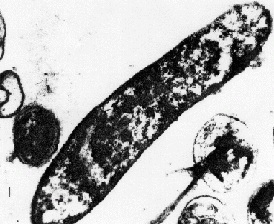 Looking at bacteria and algae: Acidic environments are difficult places to live for many plants and animals;
however, certain types of bacteria and algae can survive and flourish. These small one-celled life forms collectively
known as microorganisms can be very colorful. The colors are a result of the many different types of chemical processes,
of which these life forms are capable. For example, iron-oxidizing bacteria are able to "remove" dissolved iron in the
water and form minerals that look like rust. Many types of algae and bacteria use energy from sunlight to produce food,
similar to larger plants, in a process called photosynthesis. These processes also create changes in the chemistry of the water.
The many different types of bacteria and algae produce brilliant colors such as yellow, red, green, brown and even purple.
Looking at bacteria and algae: Acidic environments are difficult places to live for many plants and animals;
however, certain types of bacteria and algae can survive and flourish. These small one-celled life forms collectively
known as microorganisms can be very colorful. The colors are a result of the many different types of chemical processes,
of which these life forms are capable. For example, iron-oxidizing bacteria are able to "remove" dissolved iron in the
water and form minerals that look like rust. Many types of algae and bacteria use energy from sunlight to produce food,
similar to larger plants, in a process called photosynthesis. These processes also create changes in the chemistry of the water.
The many different types of bacteria and algae produce brilliant colors such as yellow, red, green, brown and even purple.
Tools and things you will need
- Baby food jars
- Eye dropper
- Gloves
- Litmus paper
- Magnifying lenses
- Microscope (if possible)
- Rubber boots
What to do?
- With an eyedropper, collect in baby food jars the different red, yellow, orange, or brown flocculates (flakes found in the water, on the rocks or on the bottom sediments) in the water. Try filling some jars all the way to the top, and leave an air space in others.
- Test each jar with litmus paper to check its pH and write down the results.
- Put the jars on a windowsill. (Put some jars on a south-facing windowsill to get direct sunlight. Put other jars on a north-facing windowsill so they do not get sunlight). Certain algae will probably develop in the jars receiving the sunlight, and certain bacteria will develop in the jars that do not receive sunlight.
- Observe over two or more weeks and take the pH of the water regularly. Take notes of what you see, including the date and time of your observations.
What did you see?
- Observe a water sample every other day with a microscope (if possible). Did swimming protozoan hatch out?
- Did any of the iron bacteria colonize (coat) the jar?
- Did any of the iron bacteria form a reddish, oily looking film at the surface between the air and the water?
- Did any of the iron bacteria form a brown ring at the top of the water?
- What else did you see?
What do you conclude?
- Did you collect acid loving iron oxidizing bacteria or neutral iron bacteria?
- How can you tell the differences? "Write down what you think."
[
Learn more...]